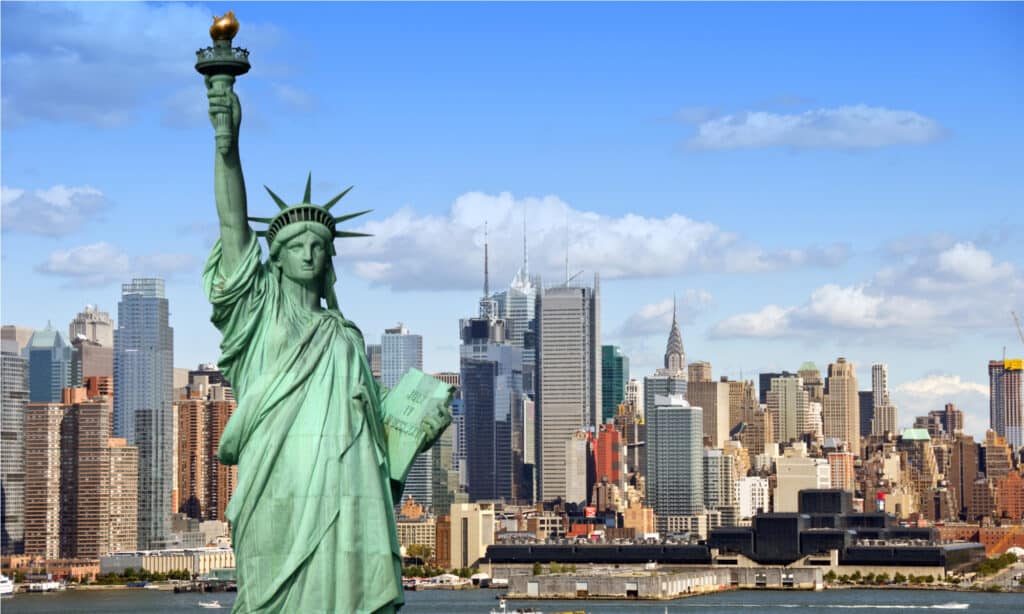
Tunnels are built for a variety of reasons, including train and vehicle transportation but sometimes, tunnels are built to ensure large cities have adequate water supply. New York City is the largest city in the U.S., and with such a dense population, it needs a steady supply of water.
The longest tunnel in the U.S. was constructed to augment the water supply for NYC but it didn’t come about easily. There was some disagreement before its construction and there is an upcoming repair project that will affect its use.
Learn more about the incredible engineering masterpiece, including what’s next for this important tunnel!

Construction for the longest tunnel in the U.S., the Delaware Aqueduct, began in 1937 and continued through 1953.
©HAER PA,52-LACK,1- (sheet 3 of 4) – License
When Was the Longest Tunnel in the U.S. Built?
Construction for the longest tunnel in the U.S., the Delaware Aqueduct, began in 1937 and continued through 1953. Its original length spans a total of 85 miles but extensions were under construction until 1965, elongating the tunnel to an incredible 105 miles.
In some parts of the tunnel, its depth runs 2,500 feet below the surface and the maximum diameter it reaches is 19.5 feet (at its end for approximately 13 miles). This tunnel is circular and makes up a portion of the system that provides water to New York City.
It starts right around the Delaware River and pulls water in from its nearby source as well as several more streams throughout the Catskill Mountains.

The aqueduct starts around the Delaware River and pulls water from its nearby source plus streams in the Catskill Mountains.
©Rabbitti/Shutterstock.com
Leaks
This tunnel isn’t just the longest in the U.S., it’s the longest throughout the world. New York City depends on this tunnel as it supplies half of its drinking water every single day. It starts in the Catskill Mountains, specifically from Rondout Reservoir, and travels all the way to the southern portion of Westchester County to the Hill View Reservoir.
Although the aqueduct has performed well for many years, it has sprung two significant leaks that were causing a loss of 20 million gallons daily. Construction for the Delaware Aqueduct Bypass Tunnel began in 2013 with an estimated cost of $1 billion with projections for the completion of the project to occur in 2023.
The two leaks in the Delaware Aqueduct were in two separate locations, including near the Hudson River and in Ulster County. The repair project has been ongoing for a decade to fix both of these leaks. The largest leak is the one located near the Hudson River and is the reason for the bypass project.
The smaller leak is under repair. The bypass tunnel was completed in 2022. It still needs a connection to the original tunnel. This will require the Delaware Aqueduct to be shut down. The shutdown was originally on schedule for 2022 through 2023 but is now for October 2023 through spring 2024.
What Was Delaware Aqueduct’s Primary Purpose?
Initially, the Board of Water Supply completed and proposed a plan to develop the Delaware water supply system in place at the time, and later, New York City placed a stamp of approval on the plan. This occurred in 1927 and although there was initial agreement, there was an intervention. The state of New Jersey and New York City could not agree to the city’s right to use the tributaries of the Delaware River.
Eventually, the Supreme Court stepped in in 1931 and upheld New York City’s right to continue with the project in order to augment its water supply using water from the Delaware River. It was agreed that the project would draw from four reservoirs, including the Cannonsville, Neversink, Pepacton, and Randout.

New York City
is the largest city in the U.S., and with such a dense population, it needs a steady supply of water.
©shutterupeire/Shutterstock.com
Wildlife Around the Delaware Aqueduct
In the upper portion of the Delaware Aqueduct, there is a diverse range of wildlife. The Upper Delaware Region is home to both land and aquatic species. Efforts to protect the river ensure that the wildlife in the area is also under protection and provides the space and resources needed to thrive.
There are over 60 fish species that live in the river and its tributaries, including cold-water fish species, migratory fish species, gamefish species, and nongame fish species. Mammals around the river include porcupines, gray foxes, black bears, eastern chipmunks, and little brown bats. Reptiles include eastern milksnakes and painted turtles.

Mammals around the river include porcupines, gray foxes, black bears, eastern chipmunks, and little brown bats.
©iStock.com/johnpane
Where is the Delaware Aqueduct Located on a Map?
The Delaware Aqueduct forms a crucial part of the New York City water supply system, drawing water from the Rondout, Cannonsville, Neversink, and Pepacton reservoirs situated on the western side of the Hudson River.
Here is the Delaware Aqueduct on a map:
Things To Do Around the Delaware Aqueduct
If wildlife viewing is your aim, you can head over to the Upper Delaware Scenic Region to enjoy the lush environment. You could also head over to the oldest wire suspension bridge in the U.S.: Roebling’s Delaware Aqueduct, which runs over the Delaware River. It’s located in Lackawaxen, Pennsylvania, and spans 535 feet.
For some entertainment, you can enjoy Hancock Town Square’s live music and cultural arts in Hancock, New York, or check out Zane Grey Museum, where you can learn about this prolific author who shared his fishing experiences from time spent along the Upper Delaware River.
Other historical museums include the Neversink Valley Area Museum and the Ten Mile River Scout Museum.
The photo featured at the top of this post is © The American Explorer/Shutterstock.com
Thank you for reading! Have some feedback for us? Contact the AZ Animals editorial team.







